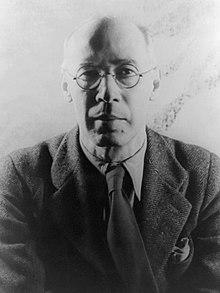Henry Miller
Henry Miller (26 December 1891 – 7 June 1980) was an American writer known for his novels. Many of his novels were partly autobiographical and used a stream of consciousness style. His most famous works are Tropic of Cancer, Black Spring, Tropic of Capricorn and The Rosy Crucifixion. They are based on his experiences in New York and Paris. They were all banned in the United States until the 1960s because they contained explicit descriptions of sex and obscene language. He also wrote travel memoirs and literary criticism and painted watercolors.[1][2][3]
Henry Miller | |
|---|---|
 Miller in 1940 | |
| Born | Henry Valentine Miller 26 December 1891 |
| Died | 7 June 1980 (aged 88) Pacific Palisades, California, U.S. |
| Nationality | American |
| Occupation | Writer |
| Signature | |
Life
changeMiller was born in New York City. His parents were German-Americans. His father worked as a tailor. Miller always wanted to be writer, but he worked at several different jobs when he was a young man. During World War I he worked as a clerk in the US War Department (now called the Department of Defense). Then he got a job as a reporter on The Washington Post. He quit that job after three days and returned to New York City. In New York he worked for the Western Union telegraph company. In 1917 he married Beatrice Sylvas Wickens, a pianist.[4]
In 1924 he left Beatrice and their child to marry the taxi dancer June Edith Smith. A taxi dancer was a woman who was paid to dance with men in dance halls. He gave up his job at the telegraph company to work full-time as a writer. Miller and June lived in Greenwich Village. They went to Paris in 1928 and stayed for a few months. He separated from June and went back to New York by himself in 1929. She later divorced him in 1934. In 1930 he went back to Paris alone. He found a job as a proofreader for the New York Herald Tribune Paris edition. A proofreader is a kind of copy editor who checks the first printing of a text for errors. He also worked on his novels. His first important novel, Tropic of Cancer, was published in Paris by the Obelisk Press in 1934. Black Spring was published in 1936 and Tropic of Capricorn in 1939. He became a close friend of the writer Anaïs Nin. She helped him get Tropic of Cancer published and wrote the preface to it. Miller stayed in Paris until June 1939.[3][4][1]
He spent the next year living on the Greek island of Corfu. On Corfu he was the guest of the writer Lawrence Durrell. Miller described his visit in his travel memoir The Colossus of Maroussi. It was published in 1941. Miller considered it to be his best work. When World War II started, Miller returned to the United States. For several years he lived in Big Sur in California. Big Sur is on the Pacific Ocean near Carmel. Many writers and artists lived there. In Big Sur Miller began work on his novel Sexus, the first part of his trilogy The Rosy Crucifixion. It was published in 1949 and tells the story of his early life in New York and first two marriages. The other two novels in the trilogy were Plexus published in 1953 and Nexus published in 1959. They continue the story of his second marriage and his years in Paris. In 1963 Miller moved to Pacific Palisades near Los Angeles. He lived there for the rest of his life.[4][1]
Miller married three more times. In 1944 he married Janina Lepska. She was a philosophy student and 30 years younger than him. They were divorced in 1952. In 1953 he married Eve McClure. She was an artist and almost 40 years younger than him. They divorced in 1962. Soon after their divorce, he married Hoki Tokuda, a Japanese entertainer. She played the piano in nightclubs. They were no longer living together when Miller died in 1980 at the age of 88. Miller had three children: Barbara from his first marriage to Beatrice Wickens and Anthony and Valentine from his third marriage to Janina Lepska.[4][5]
References
change- ↑ 1.0 1.1 1.2 Encyclopædia Britannica (2018). "Henry Miller". Retrieved 24 July 2018.
- ↑ Baxter, Annette (1961). Henry Miller: Expatriate, pp. 8–18. University of Pittsburgh Press. ISBN 0822975475
- ↑ 3.0 3.1 Campbell, James (1 June 2016). "Miller’s fail". The Times Literary Supplement. Retrieved 25 July 2018.
- ↑ 4.0 4.1 4.2 4.3 Smith, J. Y. (9 June 1980). "Author Henry Miller Dies". Washington Post. Retrieved 24 July 2018.
- ↑ The Henry Miller Memorial Library. "Henry in Big Sur" Archived 2017-08-16 at the Wayback Machine. Retrieved 25 July 2018.
Other websites
change- Henry Miller: Personal Collection Archived 2018-07-13 at the Wayback Machine The website of Henry Miller's daughter Valentine. It has a biography of Miller with photographs of his childhood and a gallery of his watercolor paintings and other art works,